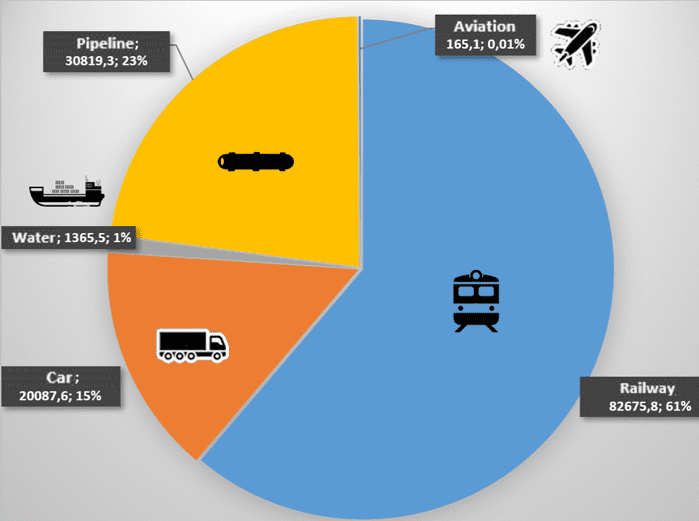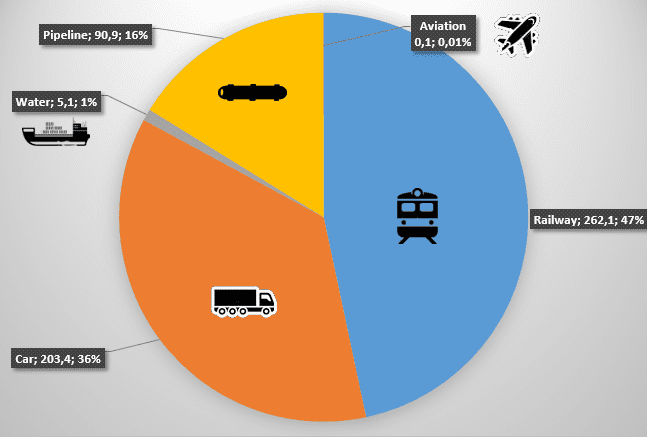
Transport enterprises of Ukraine (excluding the territory of the Autonomous Republic of Crimea and Sevastopol, as well as part of the JFO zone) in January-August 2020 reduced transportation of goods by 13.4% compared to the same period in 2019, to 382.2 million tonnes, the State Statistics Service has reported.
According to the report, the freight turnover of carriers for the specified period decreased by 17.1%, to 185.7 billion tonne-kilometers.
According to statistics, for the eight months of this year, 196.7 million tonnes of cargo were transported by rail in domestic traffic and for export, which is 5.3% less than in January-August 2019. Some 119.4 million tonnes (23.5% less) were transported by road, 3.3 million tonnes (12.4% less) by water, 62.7 million tonnes (15% less) by pipeline, and 100,000 tonnes by air (10.7% less).
Volumes of cargo transportation in Jan-June of 2020, MLn tons

 Volumes of cargo transportation in Jan-Apr of 2020, Mln tons
Volumes of cargo transportation in Jan-Apr of 2020, Mln tons

Minister of Foreign Affairs of Turkey Mevlut Cavusoglu said during a phone conversation with his Ukrainian counterpart Dmytro Kuleba that Turkey resumes regular passenger transportation with Ukraine from July 1, 2020, the Foreign Ministry of Ukraine has said.
“The foreign minister of Turkey informed [Kuleba] about the decision of the Turkish side to open its borders for foreign tourists and resume regular passenger transportation with Ukraine from July 1 this year. He also said that his country will create all necessary conditions for safe rest of Ukrainian citizens in summer,” it said on Monday.
The ministers also discussed the priority tasks of strategic partnership between Ukraine and Turkey in the near future, determined the key bilateral high-level events that will be held as soon as the epidemiological situation improves.
Kuleba and Cavusoglu also agreed to hold the next meeting of the joint strategic planning group at the level of foreign ministers of Ukraine and Turkey in Antalya.
They also discussed cooperation within international organizations, including the Council of Europe.
Volumes of cargo transportation in Ukraine in Mln tons.


Transport enterprises of Ukraine (excluding the territory of the Autonomous Republic of Crimea and Sevastopol, as well as part of the Joint Forces Operation area) in 2019 increased cargo transportation by 8% compared to 2018, to 674.5 million tonnes, the State Statistics Service has said.
According to the report, the freight turnover of carriers for the specified period increased by 2.1%, to 338.9 billion tonne-kilometers.
According to statistics, in 2019 some 262.6 million tonnes of goods were transported by rail inside the country and for export, which is 1.9% less than in 2018.
Transportation of timber decreased by 58.3%, construction materials by 19.1%, scrap metal by 21.9%, coke by 12.1%, cement by 4.9%, coal by 6.4%, ferrous metals by 5%, oil and petroleum products by 5.7%.
At the same time, transportation of iron and manganese ore increased by 2.7%, grain and cereals by 21%, chemical and mineral fertilizers by 31.5%.
In the total volume of cargo transported by water, overseas accounted for 41%. The volume of foreign cargo transportation increased by 2.3%.
In 2019, compared with 2018, the volume of goods transported by pipelines rose. The handling of ammonia grew by 13%, gas by 1.1%, oil by 0.5%. Ammonia transit increased by 16.3%, gas transit by 3.3%. Oil transit decreased by 1.6%.